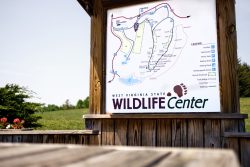Thornless Blackberry – Rubus canadensis
Brambles – Rubus spp
The genus Rubus is very difficult to identify to an individual species. There are about 20 species in West Virginia.
Twigs and Bark
Erect stems, 3 to 5 feet tall, angled cross-section, curving or sprawling canes that tend to form large thickets from root suckers. They are perennial from roots. Many species are biennial—the first-year growth (primocane) of leaves and stem but bearing no flowers—the second-year growth (floricane) producing a different set of leaves with flowers and fruits. The stems armed with spines-often without spines at higher elevations and heavily armed at lower elevations.
Leaves
Deciduous, alternate, compound, usually 5 leaflets, small spines usually on leaf margins.
Flowers
White, 5 petal and many stamens, various sized clusters.
Fruit
Black, usually elongated and round, sweet and edible. The receptacle becomes fleshy and is removed with the berry. These are the well known raspberries and blackberries.
West Virginia Range
Blackberries can be found throughout West Virginia.
Natural Habitat
Generally occupy old field and woodland clearings. They will gradually disappear as the forest returns. Allegheny blackberry and many other blackberries are common in dry places from lowlands to uplands, in woodland openings, along road-sides, in old fields, fencerows, clearings and thickets. Canadian blackberry, one of the taller and later-flowering species is very common in woods, old fields, cool hollows and along roadsides, mostly in the mountainous regions.
The most abundant and valuable summer food for wildlife in WV, juicy berries are preferred but even dried berries persisting on the canes into fall and winter are eaten to some extent. Birds are especially prominent users of the fruit. The birds include ruffed grouse, bobwhite, catbird, cardinal, chat, robin, orchard oriole, summer tanger, brown thrasher, thrushes and towhee. The fruits are also very important to animals such as black bear, raccoon, squirrels, and chipmunk. Stems and leaves are extensively eaten by deer and rabbits. The flowers are an excellent food source for bees, butterflies and moths.
The dense thickets provide valuable cover for birds, rabbits, and other smaller animals. Blackberry thickets are also common nesting sites for small birds.
Horticulture
Uses: Large masses, borders or barriers.
Light: Very light shade to full sunlight.
Soil Moisture: Moist sites are best, though various species thrive in all ranges of soil moisture.
Soil pH: Will tolerate a wide range.
Problems: Most species are free of insect and disease problems. An orange rust (Gymnoconia peckiana) often discolors leaves in WV. Thickets becoming too large from root suckers can be a problem. The sharp spines can be a problem for young children.
Compiled By: Holly Dryer-Creasy, naturalist and amateur botanist, Fairmont , West Virginia .
Written by West Virginia Native Plant Society members and jointly published with the WV Wildlife Diversity Program.



